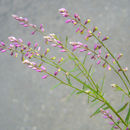Description
provided by eFloras
Herbs annual, erect, 10-50 cm tall. Stems terete, mostly much branched, glandular pubescent. Leaves alternate, subsessile, lowest 4 or 5 often in pseudowhorls; leaf blade lanceolate to linear-lanceolate, 5-20 × 1-4 mm, 1-veined, lateral veins absent, base attenuate, margin entire, apex acute. Racemes terminal or opposite to leaves, 2-15 cm. Pedicel 0.5-1 mm; basal bracteoles caducous, lanceolate, apex acute. Sepals 5; outer sepals 3, ± elliptic, apex obtuse; inner sepals 2, purple, petaloid, elliptic-oblong, ca. 2 mm, 3-veined. Petals 3, white or violet; lateral petals narrowly ovate-lanceolate, attenuate to apex; keel apex with multifid appendages. Stamens 8, forming an open staminal sheath glabrous inside and split at top into 8 very short free filaments. Ovary obovoid to nearly globose; style straight, 1.5-2 × as long as ovary, apex expanded into an oblique broad cup, upper portion of which ends in tuft of hair; stigma at base of cup. Capsule oblong, ca. 2 mm, not winged, apex notched, glabrous. Seeds black, oblong, densely white pubescent; strophiole small, with 2 membranous appendages.
- license
- cc-by-nc-sa-3.0
- copyright
- Missouri Botanical Garden, 4344 Shaw Boulevard, St. Louis, MO, 63110 USA
Habitat & Distribution
provided by eFloras
Low elevations. Guangdong, Taiwan (introduced and naturalized) [widely distributed in the tropics].
- license
- cc-by-nc-sa-3.0
- copyright
- Missouri Botanical Garden, 4344 Shaw Boulevard, St. Louis, MO, 63110 USA
Comprehensive Description
provided by North American Flora
Polygala paniculata L. PI. Jam. Pug. 18. 1759
'Polygala tenella Willd. Sp. PI. 3: 878. 1803.
Polygala paniculata normalis Kuntze. Rev. Gen. 49. 1891.
Polygala paniculata humilis Chod. Bull. Soc. Bot. Belg. 30': 301. 1891.
Polvgala paniculata verlicillata Chod. Bull. Soc. Bot. Belg. 30': 302. 1891.
Polygala paniculata i. leucoptera Blake, Contr. Gray Herb. 47: 101. 1916.
Slender erect annual, 0.6-4 dm. high, densely pedicellate-glandular; leaves whorled at extreme base of stem, otherwise alternate, linear or linear-spatulate, rarely linear-obovate, mucronate, 8-18 mm. long, 1-4 mm. wide; racemes loose, cylindric, 5-6 mm. thick, the axis becoming 9.5 cm. long; pedicels 0.7-1 mm. long; flowers rosy or purplish, rarely white; sepals ovate or oblong-ovate, obtuse, 1.3 mm. long; wings obovate or spatulate-obovate, 2-2.5 mm. long, 0.7-1 mm. wide, rounded, long-cuneate at base, 3-nerved; keel 2-2.5 mm. long, the crest of 3-4 lobes on each side; capsule elliptic, 1.7 mm. long; seed appressed-pubescent, 1.5 mm. long; aril 0.4-0.8 mm. long, the 2 lobes appressed.
Type locality: Jamaica. * Distribution: Texas; Veracruz and the West Indies to South America; introduced (f. leucoptera) in Samoa; reported also from Java (introduced).
- bibliographic citation
- John Kunkel Small, Lenda Tracy Hanks, Nathaniel Lord Britton. 1907. GERANIALES, GERANIACEAE, OXALIDACEAE, LINACEAE, ERYTHROXYLACEAE. North American flora. vol 25(1). New York Botanical Garden, New York, NY
Comprehensive Description
provided by Smithsonian Contributions to Botany
Polygala paniculata L
Polygala paniculata L., Syst. ed. 10:1154, 1759.
This widespread tropical weed has apparently not previously been reported from the Hawaiian Islands. A small colony was found on 15 April 1974 near the north coast of East Maui. It is a slender herb with short linear leaves and paniculately arranged racemes of tiny white flowers. The roots smell strongly of wintergreen, as do those of many other species of Polygala. The genus, also, is not previously known from the state.
SPECIMENS SEEN.—Hawaiian Islands: Maui: Kakipi Gulch, 6 km east of Haiku, 40 m, Fosberg & Sylva 55450 (US, UH, Fo, MO, L).
Melochia L.
- bibliographic citation
- Fosberg, F. Raymond and Sachet, Marie-Hélène. 1975. "Polynesian Plant Studies 1-5." Smithsonian Contributions to Botany. 1-25. https://doi.org/10.5479/si.0081024X.21
Polygala paniculata
provided by wikipedia EN
Polygala paniculata is a species of flowering plant in the milkwort family (Polygalaceae).[2] It is native to grasslands with altitudes between 350 and 1,700 metres (1,150 and 5,580 ft). It is native to Central and South America and has been introduced to East Africa, South Asia, and Southeast Asia.[3][4] It is an annual herb which has a height between 15 and 50 centimetres (5.9 and 19.7 in) It is used as a medicine against snake bites and blenorrhagias.[4] The flowers of the plant have been described as pink or white.[4][5]
References

- license
- cc-by-sa-3.0
- copyright
- Wikipedia authors and editors
Polygala paniculata: Brief Summary
provided by wikipedia EN
Polygala paniculata is a species of flowering plant in the milkwort family (Polygalaceae). It is native to grasslands with altitudes between 350 and 1,700 metres (1,150 and 5,580 ft). It is native to Central and South America and has been introduced to East Africa, South Asia, and Southeast Asia. It is an annual herb which has a height between 15 and 50 centimetres (5.9 and 19.7 in) It is used as a medicine against snake bites and blenorrhagias. The flowers of the plant have been described as pink or white.
- license
- cc-by-sa-3.0
- copyright
- Wikipedia authors and editors

